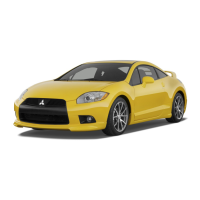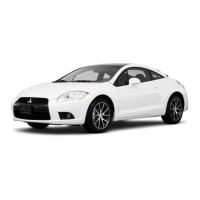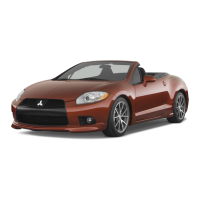ENGINE <NON-TURBO>
-
Base Engine
CONNECTING RODS
The connecting rods are different from past designs
because the manufacturing process has changed.
The connecting rod is forged as one piece from
powdered metal. The powdered metal is placed
in a form that is slightly oversized and then sent
to sintering furnace. It melts the powdered metal
in the mold. The mold travels to a forging press
where the rod is forged to the final shape. This
is done while the rod is still warm, but not molten.
After the forging process, the inside diameter of
the crankshaft end of the rod is scribed with a laser
and is fractured in a fixture. This creates a rod cap
and rod that only fit together one way. The final
step in the process is shot peening which increases
CAMSHAFT
The camshafts have six bearing journals and 2 cam
lobes per cylinder. Flanges at the rear journals con-
trol camshaft end play. Provision for cam position
CRANKSHAFT
The engine has 5 main bearings, with number 3
flanged to control thrust. The 52 mm (2.0472 in.)
diameter main and 48 mm (1.8898 in.) diameter
crank pin journals (all) have undercut fillets that
are deep rolled for added strength. To evenly distrib-
ute bearing loads and minimize internal stress, 8
counterweights are used. Hydrodynamic seals
pro-
N71ABO4AA
the surface hardness slightly. This design process
eliminates the need for several machining opera-
tions that are required for cast iron, connecting rod
assemblies. Other designs required machining the
connecting rod and connecting rod cap individually,
then finish machining, honing, and balancing are
performed as an assembly.
Note
The new process and the different metal does not
prohibit the use of standard tools. If the connecting
rods require removal from the engine a center punch
can be used to identify the correct position of the
connecting rod and cap.
N71ABOSAA
sensor on the exhaust camshaft at the rear of cylin-
der head. A hydrodynamic oil seal is used for oil
control at the front of the camshaft.
N71ABOGAA
vide end sealing, where the crankshaft exits the
block. Anaerobic gasket material is used for parting
line sealing in the block. A sintered powder metal
timing belt sprocket is mounted on the crankshaft
nose. This sprocket provides motive power; via tim-
ing belt to the camshaft sprockets (providing timed
valve actuation) and to the water pump.

